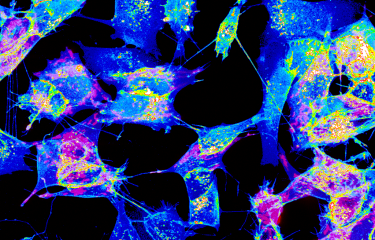Microorganisms are constantly challenged by a variety of environmental stresses. In many bacteria, the stressosome, a key inducer of the stress response is a very large machine that responds to diverse environmental changes. However, how the stressosome transmits stress signals from the environment has remained elusive. Thanks to a high-resolution microscope Titan KriosTM, researchers from the Biology and Genetics of Bacterial Cell Wall and the Bacteria-cell interactions Unit at the Institut Pasteur (Paris) in collaboration with a British group form London UCL took a first step in the roadmap to understanding the structural mechanism underpinning the role of the stressosome in the bacterial stress response.
All living organisms, from microorganism to humans have the ability to sense, respond and adapt to rapidly changing environmental conditions, including temperature extremes, nutritional or physical stress and the hostile environment of the infected host. Certain bacteria, such as the foodborne pathogen Listeria can survive harsh conditions found in a variety of food sources, such as improperly stored baked ham, cheese, frozen vegetables or ice-cream.
An important way bacteria survive in harsh environments such as contaminated food or during infection in the case of pathogens is by producing the stressosome. This large 80 unit protein complex serves as a ‘molecular switch’ that allows the bacteria to adapt and persist under harsh conditions by launching a molecular survival program. Researchers from the Biology and Genetics of Bacterial Cell Wall Unit of the Institut Pasteur in collaboration with a British group form London UCL has determined the near-atomic resolution, that is to say 1 million times smaller than a hair, structure of this stress center platform using a powerful high-resolution microscope Titan KriosTM maintained at the Diamond Synchotron platform in UK, that provided the first visual clues of how bacteria and in particular Listeria utilizes the stressosome to ensure its survival in hostile environments, becoming a potentially lethal foodborne pathogen.

“This discovery provides the most detailed molecular glimpse into how Listeria dominates its environment by mounting an effective stress response mechanism” explains Allison Williams, researcher in the Biology and Genetics of Bacterial Cell Wall Unit of the Institut Pasteur. “The power of cryoelectron microscopy is amazing. I hope this structure will motivate people to use the Titan KriosTM recently set up at the Institut Pasteur” says Pascale Cossart who leads the Bacteria-cell interactions Unit. This study paves the way toward a greater understanding of bacterial survival skills under harsh conditions providing a tangible new target for the development of effective antimicrobials.
Source
The cryo electron microscopy supramolecular structure of the bacterial stressosome unveils its mechanism of activation, Nature Communications, July 8th, 2019
Allison H. Williams1,7, Adam Redzej2,7, Nathalie Rolhion3,4,5, Tiago R.D. Costa2,6, Aline Rifflet1, Gabriel Waksman2 & Pascale Cossart3,4,5
1 Unité Biologie et Génétique de la Paroi Bactérienne, Institut Pasteur, Groupe Avenir, INSERM, 75015 Paris, France
2 Institute of Structural and Molecular Biology, University College London and Birkbeck, Malet Street, London WC1E 7HX, UK
3 Département de Biologie Cellulaire et Infection, Institut Pasteur, Unité des Interactions Bactéries-Cellules, F-75015 Paris, France
4 Inserm, U604, F-75015 Paris, France
5 INRA, Unité sous-contrat 2020, F-75015 Paris, France.6 MRC Centre for Molecular Bacteriology and Infection, Department of Life Sciences, Imperial College London, London, UK
7 These authors contributed equally: Allison H. Williams, Adam Redzej
Titan KriosTM, a closer look on life
Viruses, components of a cell, or protein complexes: with the Titan Krios™ microscope (Thermo Scientific™ Krios™ Cryo-TEM), by Thermo Fisher Scientific), all of these structures and biological phenomena can be visualized with a level of detail thus far unparalleled. This microscope facilitates the observation, at very high resolution, of the most fragile samples closer to their natural conditions, thanks in particular to the preparation of these samples using cryogenic techniques. Combined with a high-performance camera, imaging under cryogenic conditions provides three-dimensional rendering with unprecedented accuracy. With the Titan Krios™, the Institut Pasteur now provides its researchers with a tool of extraordinary power to observe cells as close to life as possible.

This study is part of the priority scientific area Antimicrobial Resistance of the Institut Pasteur's strategic plan for 2019-2023.









